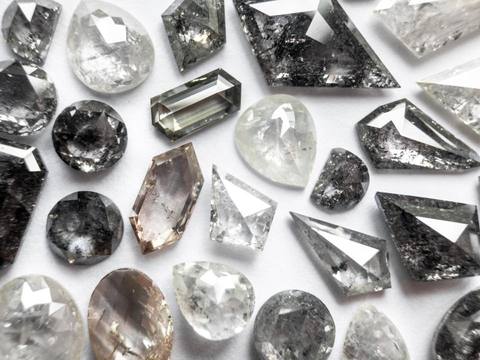Collection: Diamond inspiration
How are diamonds formed?
Diamonds are formed deep within the Earth about 100 miles or so below the surface in the upper mantle. Obviously in that part of the Earth it's very hot. There's a lot of pressure, the weight of the overlying rock bearing down, so that combination of high temperature and high pressure is what's necessary to grow diamond crystals in the Earth. As far as we know, all diamonds that formed in the Earth formed under those kinds of conditions and, of course, that's a part of the Earth we can't directly sample. We don't have any way of drilling to that depth or any other way of traveling down to the upper mantle of the Earth.
How do diamonds travel to the surface of the Earth?
The diamonds that we see at the surface are ones then that are brought to the surface by a very deep-seated volcanic eruption. It's a very special kind of eruption, thought to be quite violent, that occurred a long time ago in the Earth's history. We haven't seen such eruptions in recent times. They were probably at a time when the earth was hotter, and that's probably why those eruptions were more deeply rooted. These eruptions then carried the already-formed diamonds from the upper mantle to the surface of the Earth. When the eruption reached the surface it built up a mound of volcanic material that eventually cooled, and the diamonds are contained within that. These are the so-called Kimberlites that are typically the sources of many of the world's mined diamonds.
One of the things we know, therefore, about any diamonds that were brought to the surface is that the process of the Kimberlite eruption bringing the diamonds from the upper mantle to the surface of the Earth had to happen very quickly, because if they were traveling too long and too slowly they would have literally turned into graphite along the way. And so by moving quickly they essentially got locked into place into the diamond structure. Once the diamonds have been brought from high temperature to low temperature very quickly—and by quickly, we mean in a matter of hours—these eruptions, these Kimberlite pipes moving to the surface, may have been traveling at rates of 20 to 30 miles per hour. Once the diamonds are brought to the surface and cooled relatively quickly, those carbon atoms are locked into place and there's just not enough energy to now start rearranging them into graphite.
What is carbon's role in forming diamonds?
Diamonds are made of carbon so they form as carbon atoms under a high temperature and pressure; they bond together to start growing crystals. Because of the temperature and pressure, under these conditions, carbon atoms will bond to each other in this very strong type of bonding where each carbon atom is bonded to four other carbon atoms. That's why a diamond is such a hard material because you have each carbon atom participating in four of these very strong covalent bonds that form between carbon atoms. So as a result you get this hard material. Again where the carbon is coming from, how quickly they're growing, those are all still open questions, but obviously the conditions are such that you've got some group of carbon atoms that are in close enough proximity that they start to bond. As other carbon atoms move into the vicinity they will attach on. That's the way any crystal grows. It's the process of atoms locking into place that produces this repeating network, this structure of carbon atoms, that eventually grows large enough that it produces crystals that we can see. Each of these crystals, each diamond, one carat diamond, represents literally billions and billions of carbon atoms that all had to lock into place to form this very orderly crystalline structure.
You mentioned that scientists don't know where the carbon comes from. What are some possible sources?
In some cases, the carbon seems to have originated within the mantle of the Earth, so carbon that was already in the Earth. In other cases, there's evidence very curiously to suggest that the carbon may have originated near the surface of the Earth. The thinking there is that this carbon could have literally been carbon that was part of carbonate sediments or animals, plants, shells, whatever, that was carried down into the upper mantle of the Earth by the plate tectonics mechanism called subduction.
How long does it take diamonds to form?
We really don't know how long it takes. There have been attempts to try to date inclusions in different parts of diamonds, and those have largely been unsuccessful. It may be that diamonds form over periods as short a time as days, weeks, months to millions of years. Typically, as with many crystals that grow on the Earth, it's not a continuous process. The diamonds may start to grow and then there may be an interruption for some reason – a change in conditions, temperature, pressure, source of carbon, whatever—and they could sit for millions, hundreds of million of years, and then start growing again. That's part of the problem of trying to put some sort of a growth period on them; things don't always occur continuously in the Earth.
We can grow diamonds in the lab and we can simulate conditions there. But there are things we have to do to grow diamonds in the laboratory that aren't obvious as to how it happens in the Earth. In the laboratory, they're typically grown, but there's some catalyst. Some metals are often added to cause the diamonds to grow, but these same catalysts are not observed in the diamonds from the upper mantle of the Earth.
How old then are diamonds?
All diamonds, as far as we know, are quite old in the Earth. Most diamond formation probably took place in the Earth in the first couple billion years of the Earth's history. There are diamond deposits that have been discovered that are younger—the rock itself, the Kimberlite, is maybe just tens of hundreds of millions of years old. The way they date diamonds is typically looking at inclusions of other minerals in the diamond that can be radioactively dated. The diamonds themselves can't be dated. But if the mineral inclusions contain certain elements like potassium and things that can be used in a radioactive dating scheme, then by dating the inclusion in the diamond you get some sense of the age of the diamond itself. And those dates always suggest the diamonds are quite old. At least hundreds of millions of years old, but in most cases billions of years old, anywhere from one to three billion years old, a time when the earth was probably hotter than it is today and so conditions were perhaps more appropriate for diamond growth.

-
Salt and Pepper Diamonds
Regular price $ 0.00 CADRegular priceUnit price / per

